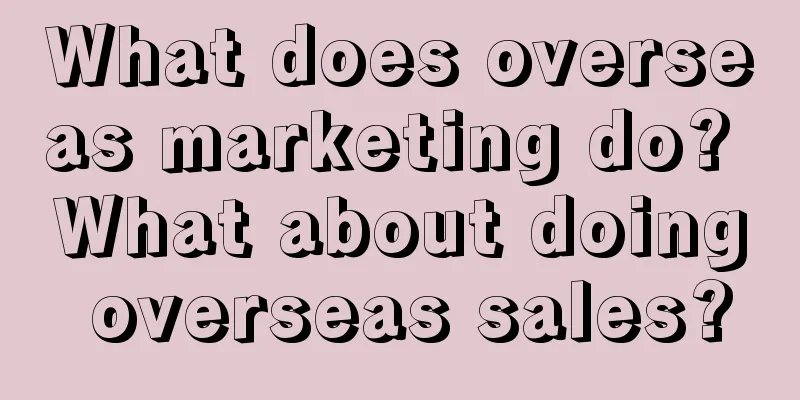How to understand the meaning of data? (Popular version)

Many new employees don’t understand the meaning of data. When they look at the report, they just keep repeating like a repeater: “Yesterday’s sales were 100, today’s sales were 120, an increase of 20…” These are things that anyone who is not blind can see. They are often laughed at for this. What can I do? ! 1. Understand the first stage: clear indicatorsGive a number: 180, can you understand its meaning? cannot! Because it is just a single number, without any meaning. To understand the data, at least it must be a clear data indicator. It includes the indicator name, usage scenario, and calculation caliber. The same 180, we change it to: adult female, height 180cm. Isn't it much clearer now? 2. Understanding the Second Stage: Setting StandardsAnd many people may have already made an instinctive judgment: this girl is very tall. This judgment may be based on statistical data. According to the 2015 "Report on the Nutrition and Chronic Disease Status of Chinese Residents", the report shows that the average height of adult males is 167.1cm and that of females is 155.8cm, which means that 180cm is taller than many men. It can be defined as tall. This judgment may also be based on established habits. For example, according to custom, girls over 170cm are considered tall, and 180cm is even taller. They are definitely considered tall. There is nothing wrong with either judgment. In fact, both are ways to further understand the data: statistical method and customary method. The statistical method divides data into high, medium and low based on statistical differences. The customary method quantifies people's customary habits. From "adult female, height 180cm" to "adult female, very tall" is an important transition in understanding the data. Because 180cm is an objective value, it cannot directly affect our decision. But "tall" is a judgment result, and this judgment will affect our decision. If you don't believe it, keep reading. 3. Understanding the third stage: scene matchingScene 1: Xiao Ming is 175cm tall, and his second aunt enthusiastically introduces a girl who is 180cm tall to him for a blind date. Scenario 2: Xiao Ming is organizing an exhibition and needs 5 models. HR Linda introduces a 180cm tall girl to him. Ask Xiao Ming how he feels in the two scenarios? Some girls dislike boys who are shorter than themselves. Unfortunately, Xiao Ming is a handsome guy who has been deeply disliked. So when Xiao Ming encounters scenario 1, he will probably curse directly: "I told you not to find someone taller than me. Are you really trying to embarrass me?" - This is the result of ignoring other people's requests. Xiao Ming will probably be very happy in scenario 2. Models at exhibitions must be tall and pretty, so that they can be well presented. Of course, the appearance fee is much more expensive. If you want to save money at this time and just find a few short girls, the boss will probably scold you when he sees their height - you are paid for it, but you don't use it to cover your butt instead of the storefront! Therefore, if you want to understand the data in depth, you must combine it with specific scenarios. There are two ways to do this: 1. Deduction based on business logic 2. Based on past experience Both methods require a deep understanding of the business scenario (as shown below): 4. Understanding the Fourth Stage: Observing the SituationAfter the first three stages, we know the following information:
Based on these, looking at the data again will lead to new interpretations. For example, if you are responsible for planning an exhibition, the height of the models recommended by your advertising company is as follows: After reading this, you may immediately interpret it as: These bastards are trying to cheat me out of my fees again! They secretly replaced me with a batch of cheap models! Yes, this interpretation is one step further than "Oh, the height has shrunk so much", this is the fourth stage of interpretation. If you don't read this out and send the same data directly to your leader, the leader may immediately interpret it as: This new guy doesn't understand the business, how can he do such a shabby job? If the leaders do not handle the same data and just invite a group of random people to the exhibition, your dealers will immediately understand: Oh, is there something wrong with the brand strength this year? The exhibition area has shrunk, the new product launch is not enthusiastic, and the models are just for show. It's not good. All of these are based on a height data. As the saying goes, seeing the big picture from the small details, there are actually logical reasonings behind them (as shown below) 5. The difference between understanding and reading at randomOf course, there are limits to how much you can interpret data; over-interpretation or random guessing can lead to misunderstandings. For example: Random guess: You see, the models are all beautiful, so their bosses must be lustful. Over-interpretation: You see, nine beautiful models were hired this time, so there must be nine products being released. The biggest difference between understanding and random guessing is the amount of evidence. For example, the dealer questioned the strength of the brand, not just by looking at the height changes of the models, but also by looking at the booth and the new product launch. With multiple pieces of evidence to support it, the interpretation is naturally close to the truth. Random guesses are often unfounded (what about the evidence of lust?) Over-interpretation often lacks a single piece of evidence (besides the nine models, is there any other evidence?). Of course, it does not rule out that we will have a new interpretation after we obtain more evidence. Logic + amount of evidence is the only criterion for judging data interpretation. As long as there is sufficient evidence + reasonable logic, we have reason to accept the conclusion. 6. Why is it difficult to interpret data in the enterprise?Why is it easy to interpret data in examples, but difficult in actual work? Answer: Because examples such as height, blind dates, and exhibition models have very simple and clear business meanings and are easy to understand. However, in actual work, data analysts are often divorced from the business and have no idea about specific sales, operations, products, after-sales, etc. They can only make simple guesses based on a few numbers such as sales, gross profit, activity rate, conversion rate, etc. Common questions, such as: I don't understand the business meaning: Why do blind dates care about height? Isn't it to see if there is a feeling? I don’t understand the business situation: Why doesn’t Xiao Ming like tall girls? Tall girls are beautiful! I don’t understand the business logic: Why do we have to find tall models for the exhibition? Can’t we just have a few random people? The result is that there is no way to judge the data. So all we can do is to write meaningless accounts such as "yesterday's sales volume was 120, today's sales volume is 140, an increase of 20, an increase of 16.7%". The key is that these judgments are likely to be common sense in the eyes of the business, so in the communication, there is an embarrassing situation of "the business is too lazy to talk, and the data is not asked". When the blame is finally put on the data analyst, he still pitifully said: I have never been on a blind date, and I have never held an exhibition, woo woo woo... Therefore, if you want to interpret deeply and specifically, you have to be close to the business, learn to abstract the meaning of data from specific operations, and quantify the judgment of the business party. Author: Down-to-earth Teacher Chen WeChat public account: Down-to-earth Teacher Chen |
<<: Why has the business of Dali’s travel photo studio gone so bad?
Recommend
How to calculate Amazon advertising budget? What are the methods?
On the Amazon platform, many people usually do pro...
What ERP is generally used in cross-border e-commerce? Introduction to the top ten cross-border e-commerce ERPs
Merchants in the cross-border e-commerce industry ...
Which platform is better for cross-border independent stations? What platforms are there?
When it comes to cross-border e-commerce, I believ...
What kind of applications will AIGC have in the ToB business model?
This article introduces several different roles th...
Data analysts PK operations, no more being chased for numbers!
For data analysts, the endless demand for data is ...
Will Xiaohongshu change its direction again in the second half of 2024? How to sell goods in the e-commerce era!
As a platform integrating e-commerce and social me...
What is the process of building a cross-border e-commerce platform? How to do it?
In the cross-border e-commerce industry, the model...
From "trainees" to "stall vendors" in parks, young people are starting a new trend of career exploration
Quitting without a job, taking a gap year, changin...
How to register a local seller on Shopee? What are the advantages?
When opening a store on Shopee, merchants can choo...
You must know about these 3 distribution channels of Xiaohongshu!
This article introduces in detail the three differ...
Is the Vova cross-border e-commerce platform closed? How is this platform?
In recent years, with the vigorous development of ...
The whole story of the Oriental Selection Essay Incident! And the top ten problems are dismantled
This article reviews the "Essay" inciden...
Unlocking the secrets of consumers' hearts: How to use subconscious marketing?
This article is about marketing and discusses the ...
Does Pop Mart need to tear off the “blind box” label?
This article mainly analyzes the current status of...
Cats and dogs spell "slash" short play: poison or antidote?
The rustic short dramas that once dominated Kuaish...









